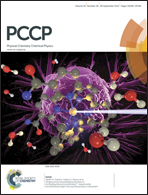Generation of free oxygen atoms O(3P) in solution by photolysis of 4-benzoylpyridine N-oxide†
Abstract
Laser flash photolysis of 4-benzoylpyridine N-oxide (BPyO) at 308 nm in aqueous solutions generates a triplet excited state 3BPyO* that absorbs strongly in the visible, λmax 490 and 380 nm. 3BPyO* decays with the rate law kdecay/s−1 = (3.3 ± 0.9) × 104 + (1.5 ± 0.2) × 109 [BPyO] to generate a mixture of isomeric hydroxylated benzoylpyridines, BPy(OH), in addition to small amounts of oxygen atoms, O(3P). Molecular oxygen quenches 3BPyO*, kQ = 1.4 × 109 M−1 s−1, but the yields of O(3P) increase in O2-saturated solutions to 36%. Other triplet quenchers have a similar effect, which rules out the observed 3BPyO* as a source of O(3P). It is concluded that O(3P) is produced from either 1BPyO* or a short-lived, unobserved, higher energy triplet generated directly from 1BPyO*. 3BPyO* is reduced by Fe2+ and by ABTS2− to the radical anion BPyO˙− which exhibits a maximum at 510 nm, ε = 2200 M−1 cm−1. The anion engages in back electron transfer with ABTS˙− with k = 1.7 × 109 M−1 s−1. The same species can be generated by reducing ground state BPyO with ˙C(CH3)2OH. The photochemistry of BPyO in acetonitrile is similar to that in aqueous solutions.


 Please wait while we load your content...
Please wait while we load your content...